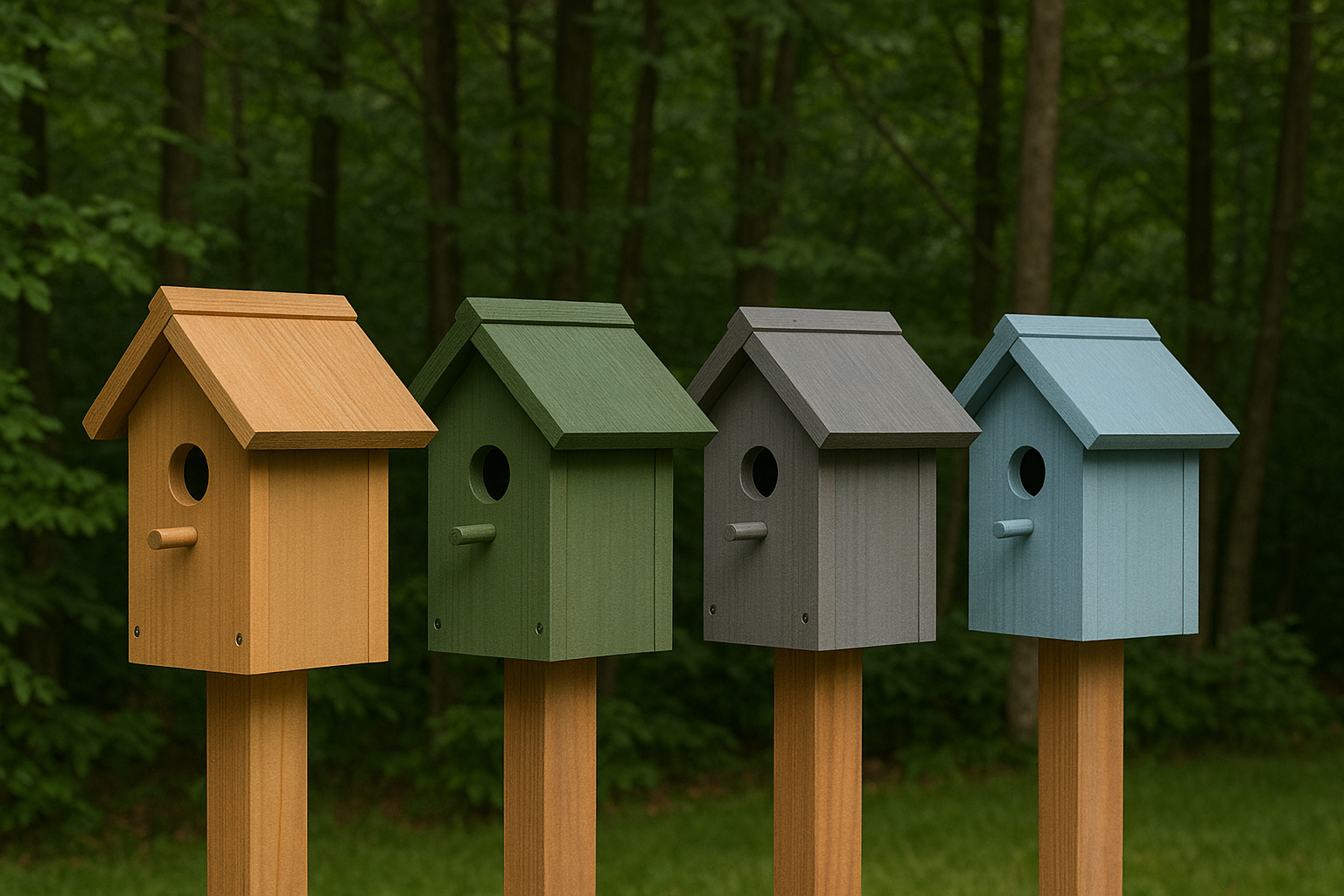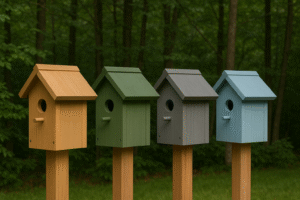What Color Should a Birdhouse Be? An Expert Guide to Choosing the Right Paint

It’s a tempting vision: a bright, cheerfully colored birdhouse, a splash of personality in the garden that perfectly matches the trim on your home. Craft stores are filled with them, and a quick search online reveals a rainbow of whimsical designs. But as I stood in my workshop years ago, a can of vibrant red paint in hand, a question stopped me: am I painting this for myself, or am I painting it for the birds?
That question sent me down a fascinating rabbit hole of ornithology, bird behavior, and predator psychology. I learned that for a bird choosing a place to raise its young, the color of a nest box is not a matter of aesthetics; it’s a critical factor in a complex survival calculation. The wrong color can be a flashing neon sign for a hawk, a heat trap on a summer day, or simply an unnatural object that a cautious bird will avoid at all costs. Since that day, I’ve only used a specific palette of colors on the houses I build and maintain, a choice guided by science, not style.
This guide will share everything I’ve learned. We’ll explore the incredible world of bird vision, debunk common myths about color, and provide a clear, science-backed palette of the best colors for your birdhouse to ensure it becomes a safe, successful home.
The Short Answer: Go Natural
The best colors for a birdhouse are natural, earthy tones that camouflage the box and blend it into its surroundings. Birds are attracted to safety, and a house that disappears into the background is a safe house. Your primary goal is to mimic the natural environment.
- Best Colors: Browns, dull greens, grays, and tans that match tree bark and foliage.
- Worst Colors: Bright colors like red, yellow, orange, and pink, which attract predators. Dark colors like black or navy blue, which can cause the house to overheat.
- The Bottom Line: When in doubt, leave a high-quality cedar or pine birdhouse unpainted. The natural, weathered wood is a perfect color.
The Science of Survival: Why Color Matters So Much
To understand why a gray birdhouse is more appealing than a yellow one, we need to look at the world from a bird’s perspective. Their decisions are driven by instincts honed over millennia, and two factors are paramount: predator avoidance and thermoregulation.
Camouflage is King: Hiding from Predators
A nesting box is a concentrated buffet of high-protein eggs and vulnerable chicks. To predators like hawks, jays, raccoons, and snakes, it’s a prime target. Birds instinctively know this. They are genetically programmed to seek out nesting sites that are inconspicuous. A bright blue or cheery red box stands out against the greens and browns of a garden, acting like a giant “X marks the spot” for any predator scanning the area.
A house painted in a muted, natural color, however, blends into the dappled light of a tree line or the texture of tree bark. It becomes part of the background, easily overlooked by a passing threat. This principle is the single most important factor in choosing a color. The question you should always ask is not “What color do birds like?” but “What color will make this house invisible?”
Keeping Cool: The Dangers of a Dark House
A birdhouse is an enclosed cavity, and its internal temperature can be life-threatening. Dark colors, especially black, navy blue, and dark brown, absorb a tremendous amount of solar radiation. On a sunny summer day, the inside of a dark-colored birdhouse can heat up like an oven, reaching temperatures that will kill nestlings. This is why natural, lighter shades or the reflective properties of white are often safer choices, especially in hotter climates.
The Official Birdhouse Color Palette: What Science Recommends
Based on the principles of camouflage and thermoregulation, here is the expert-approved palette for painting your birdhouse.
✓ The “Good” Colors
- Earthy Browns: Mimics tree trunks and soil. An excellent, safe choice for any environment.
- Leafy Greens: Dull, olive, or leafy greens blend seamlessly into a background of foliage. Avoid bright, artificial greens.
- Stone Grays: A battleship gray or a lighter stone color is fantastic for mimicking the color of weathered wood and tree bark.
- Natural Tans: A simple beige or tan is a wonderful neutral color that blends in almost anywhere.
✗ The “Bad” Colors
- Bright & Bold: Red, yellow, orange, pink, purple, and bright blue. These are unnatural and serve as a beacon for predators.
- Black & Dark Blue: These absorb too much heat and can cause the nest box to dangerously overheat.
- Metallic Paints: These are unnatural and may contain toxic components.
- Glossy Finishes: A high-gloss finish can create an unnatural sheen that reflects light and draws attention.
The Best “Color” of All: Natural, Unpainted Wood
When in doubt, the best approach is to do nothing at all. A birdhouse made from a high-quality, weather-resistant wood like cedar or pine is perfect right out of the box. As it weathers, it will turn a beautiful, silvery gray that is the ultimate natural camouflage. This is why so many of the houses in our birdhouse reviews are made from these woods. They require no cosmetic enhancement to be effective.

The Perfect Natural Finish: Nature’s Way Cedar Bluebird Box
This birdhouse is a prime example of why unpainted is often best. It’s constructed from naturally rot-resistant and insect-resistant cedar. The wood’s natural tan and brown tones are perfect camouflage as-is. Over the seasons, it will slowly weather to a soft, silvery gray, blending in even more effectively with its surroundings. By choosing a house made from the right materials, you get a perfect, bird-safe “color” with zero effort.
Check Price on AmazonHow to Safely Paint a Birdhouse: A Step-by-Step Guide
If you have a pine birdhouse that needs protection from the elements, or you simply want to add a touch of natural color, it’s crucial to do it safely.
- Choose the Right Paint: You must use a **non-toxic, water-based latex or acrylic paint**. Look for paints labeled “zero-VOC” or “low-VOC” (Volatile Organic Compounds). Never use oil-based paints, which contain harmful solvents. A flat or satin finish is much better than a glossy one.
- Paint the EXTERIOR ONLY: This is a critical rule. Never, ever paint the inside of the birdhouse. The raw wood on the interior provides a rough surface that helps the young birds grip the walls to climb out when it’s time to fledge. Paint can also release fumes in the enclosed space that are harmful to chicks.
- Avoid the Entrance Hole: Do not paint the entrance hole or any area immediately around it. Birds will be pecking and rubbing against this area, and you don’t want them ingesting paint chips.
- Let it Cure Completely: “Drying” and “curing” are two different things. Paint may be dry to the touch in a few hours, but it can take weeks to fully cure and off-gas all its chemical compounds. Paint your birdhouse in the fall or winter and let it air out in a shed or garage for at least a month before putting it up for the spring nesting season.

The Safest Paint for the Job: FolkArt Home Decor Chalk Paint
When I need to paint a birdhouse, this is the type of paint I reach for. This FolkArt chalk paint is non-toxic, water-based, and has very low odor and VOCs, making it safe for wildlife projects. It dries to a beautiful, ultra-matte finish that provides a natural, non-reflective look perfect for camouflage. It comes in a wide variety of earthy tones like “Castle Gray” or “Sage Green.” It adheres well to wood and is durable enough for outdoor use. It’s the ideal choice for safely adding a touch of natural color to your birdhouse.
Check Price on AmazonThe Great Exception: The Curious Case of the White Purple Martin House
Walk through any area with a thriving Purple Martin colony, and you’ll see a sea of bright white houses and gourds. This seems to fly in the face of everything we’ve discussed. So, why is white the standard for this one species?
- Heat Reflection: Purple Martin houses are placed in the middle of wide-open fields, with zero shade, to give the birds the clear flight paths they require. In this exposed environment, a dark-colored house would be a death trap. Bright white is the most effective color for reflecting solar radiation and keeping the multiple compartments of a martin house at a safe temperature.
- Colony Visibility: Purple Martins are colonial nesters. A large, bright white house is highly visible from the air, acting as a beacon that helps migrating martins spot a potential colony site from a great distance.
This is a highly specialized adaptation for a single species. For the vast majority of backyard birds like wrens, chickadees, and bluebirds, the rule of camouflage still applies.
Frequently Asked Questions (FAQ)
My birdhouse is already painted a bright color. Should I repaint it?
Yes, I would strongly recommend it. If birds have avoided it for a season or more, the color is a likely culprit. You can lightly sand the exterior and then apply two coats of a safe, water-based paint in a natural, earthy tone.
What about decorative, patterned, or “themed” birdhouses?
While whimsical and fun for humans, these are generally poor choices for birds. The busy patterns and bright colors do nothing to camouflage the house and can make it a target. Function should always come before fashion when choosing a birdhouse. For more on what makes a good house, see our guide on how to get birds to use a birdhouse.
I heard that a red birdhouse will attract hummingbirds. Is this true?
This is a common and dangerous myth that comes from confusing feeders with houses. Hummingbirds are attracted to the color red on *feeders* because they associate it with nectar-rich flowers. However, hummingbirds do NOT use birdhouses of any color. They build their own tiny, delicate nests on tree branches. Putting up a red birdhouse will not attract them; it will only endanger the cavity-nesting birds you’re trying to help.
Is it more important to have the right color or the right location?
Location, 100%. A perfectly colored birdhouse in a bad location will sit empty, while a garishly colored house in the absolute perfect spot might eventually get a desperate tenant. However, to maximize your chances of success and ensure the birds are as safe as possible, you need both: the right color in the right place. Placement, especially mounting on one of the best birdhouse poles with a baffle, is the foundation of a successful birdhouse.
Conclusion: A Palette Chosen by Nature
Choosing the color for a birdhouse is a simple but profound act. It’s an opportunity to move beyond our human-centric view of the world and make a choice based on the real, life-or-death needs of the creatures we want to help. By embracing a palette of browns, grays, and greens, you are providing the gift of camouflage. You are making your birdhouse a safer, more desirable home, invisible to predators but a welcome sight to the discerning eye of a prospecting bird.
So, put away the bright colors. Let nature be your guide. Your reward will be the quiet satisfaction of knowing you’ve created a true sanctuary, a home designed not just to be seen, but to disappear.

